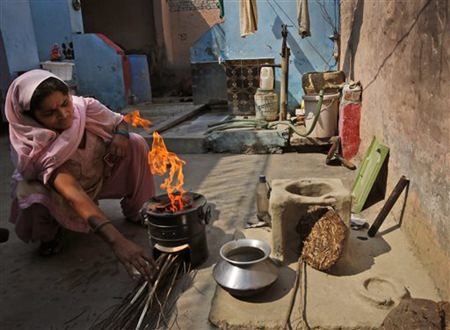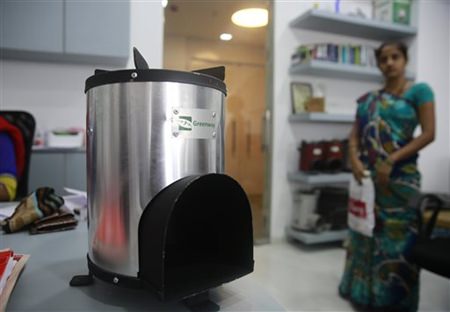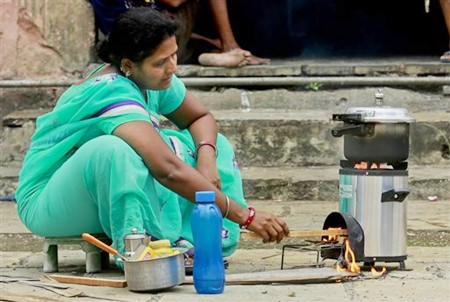GANORA SHEIKH VILLAGE, India (AP) — Kamlesh feeds the flames of a crude clay cookstove with kindling, kerosene and sunbaked discs of cow dung. She breathes in the billowing smoke, as she does for hours every day. Her eyes water and sting. Her throat feels scratchy and sore.
Kamlesh is one of hundreds of millions of Indian housewives who, with the simple act of cooking family meals, fill their homes every day with deadly airborne pollutants. The constant exposure to indoor air pollution kills some 4.3 million people every year across the world — 30 percent of them in India.
The menace of cookstove pollution, which contains high concentrations of tiny particles known as black carbon, does not stop in the home. It compounds many environmental problems as well, from glacial melt to falling crop yields.
 Indian woman Rekha Devi lights her new fuel-efficient cook stove next to her old clay stove in her house at a village near Bulandshahr, Uttar Pradesh, India.(AP Photo/Manish Swarup)
Indian woman Rekha Devi lights her new fuel-efficient cook stove next to her old clay stove in her house at a village near Bulandshahr, Uttar Pradesh, India.(AP Photo/Manish Swarup)
India, the world’s third largest climate polluting nation, has spent decades encouraging cleaner cooking technologies, with limited success. Such a shift would have little impact on India’s emissions of climate-warming greenhouse gases, and many of the alternatives pollute as well.
But countries like India — far behind the industrialized world in economic and infrastructure development — argue that it’s a crucial step in saving lives and ensuring energy justice for the poor.
Impoverished women like 40-year-old Kamlesh remain unconvinced. She and her neighbors in Ganora Sheikh, a north Indian village about 80 kilometers (50 miles) from New Delhi, aren’t thinking about the climate, or about melting glaciers hundreds of kilometers (miles) away. They wonder why they should spend $30 to $60 on a cookstove when they can build a fire and find fuel in the forest for free.
 A Biomass stove is displayed at the office of cookstove developer Greenway Appliances.(AP Photo/Rafiq Maqbool)
A Biomass stove is displayed at the office of cookstove developer Greenway Appliances.(AP Photo/Rafiq Maqbool)
Even as Kamlesh, who goes by one name, complained that cooking on her old stove “is very difficult … the smoke, the heat, it makes my eyes burn,” she doubted any of the smoke-free alternatives could do the job right.
The fire-roasted flatbreads called roti and naan that are a staple across northern India just don’t have the same smoky flavor if cooked on a gas-fired or fuel-efficient stove. “If we can’t make roti, then what will we eat? Nothing can replace roti.”
 Hansa Arjun 36, an employee of cookstove developer Greenway Appliances, demonstrates the use of Biomass stove.(AP Photo/Rafiq Maqbool)
Hansa Arjun 36, an employee of cookstove developer Greenway Appliances, demonstrates the use of Biomass stove.(AP Photo/Rafiq Maqbool)
Pure black carbon is a significant climate pollutant, with some studies suggesting it is responsible for up to 20 percent of climate change. It is also a major component of the tiny particulate matter known as PM2.5 that is now one of the most common measures for air pollution.
About a quarter of the world’s black carbon pollution comes from cookstoves, with the rest released by car exhaust, forest fires, agricultural burning and other sources.
The soot is blackening glaciers and polar ice so that they absorb more solar radiation and melt more quickly. It’s creating hazy layers in the atmosphere that block sunshine from reaching the Earth, a phenomenon called “global dimming” that can harm crops. And it messes with the weather by interacting with clouds in complex ways.
But black carbon, the product of incomplete combustion, is rarely released alone. It depends on what’s being burnt, but it usually comes with a messy cocktail of other polluting compounds including organic carbon and sulfates, which can actually have the opposite effect on climate by limiting the rise in temperatures.
The Intergovernmental Panel on Climate Change, which compiles and analyzes climate-related research every four years, has so far left the topic of black carbon out of its assessments. It is a short-term pollutant, dissipating within days whereas greenhouse gases like carbon dioxide and methane will linger for decades in the atmosphere. As of now, black carbon pollution is entirely unregulated, poorly measured and unevenly distributed, pooling in the air above wherever it was released.
The climate-change benefits of replacing traditional cookstoves are even more muddled because common replacements also pollute. Gas stoves create more emissions of methane, a highly potent greenhouse gas. Emissions from electric stoves depend on how the electricity is generated; in India, it’s largely from coal, another major contributor to global warming.
“It can be politically incorrect to advocate for gas cooking, since it’s not a renewable energy source,” said Kirk R. Smith, professor of global environmental health at the University of California, Berkeley.
Still, he and other atmospheric health experts say the health benefits justify the change. According to his research, if all 2.8 billion people still cooking with old-world fuels suddenly switched to gas, the increase in global emissions would equal just a half-a-percent change in the efficiency of the world’s automobile fleet.
“You can’t blame the poor for climate change,” Smith said. “It’s rather a strange idea to put the poor at the margin when we’re not doing all that much ourselves” to cut electricity consumption or switch away from fossil fuels.
Despite the unknowns, India has listed cleaner cooking as part of its national climate action plan, submitted to the U.N. last month before the world’s nations begin negotiating a new agreement to limit climate-warming greenhouse gases.
Unlike many countries, India is not promising any overall emissions cuts. It expects its emissions to continue to grow as its economy expands, but the increase relative to economic output will decline.
India has made no calculations to determine how much of an impact a cookstove transition could make, Renewable Energy Secretary Varsha Joshi said. “We are making the connection with indoor air pollution. It’s not all about the emissions,” she said.
India’s new measures for promoting cleaner cooking include asking citizens to give up cooking gas subsidies so they could instead be spent on extending cleaner-cooking options to the poor. Energy Minister Piyush Goyal said they’re aimed at helping those “who’ve been deprived of clean energy sources for years.” Already, 2 million Indians have waived the subsidy.
The problem is not limited to India. Countries from China and Ethiopia are also pushing cookstove programs. In Nigeria, where deforestation has become a major concern, the government said last year it would distribute some 750,000 clean cookstoves in order to keep people from harvesting so much wood.
The Global Alliance for Clean Cookstoves, a U.N. foundation working to develop a viable cookstove market, will have helped distribute 43 million cookstoves worldwide by the end of the year by linking manufacturers and developers with investors and other financial support mechanisms.
The potential market is at least 10 times that size, likely more given that many homes use more than one stove.
“When you multiply the effects by 500 million households,” alliance CEO Radha Muthiah said, “it’s clear that scaling it up can have a substantial impact for health and the environment.”
Back in Ganora Sheikh, Rekha Devi couldn’t be happier with her new fuel-efficient cookstove. She needs half the time to cook dinner as before. She can move the new stove around and bring it indoors when it rains. The walls no longer turn black with the stain of soot. And the great plumes of smoke she once breathed have been reduced to faint ribbons wafting into the air.
“Everything is better,” the 40-year-old housewife said.
Yet six months after the black, metal-cylinder stoves became available for about 2,000 rupees ($30), she is still the only person in the village to switch.
While India has had some sort of clean-cooking program since the 1950s, the number of people who rely on burning wood and cow dung has remained steadfast around 700 million since 1980. That’s partly because the population has risen, and partly because the programs have had limited impact.
That may change as the commercial market grows with more manufacturers seeking bank loans, carbon credits and other funding instruments.
“India is a peculiar market. You go into a typical household, and they will have a TV, a couple of mobile phones. And yet somehow the kitchen is still 50 years behind the rest of the house,” said Neha Juneja, co-founder and CEO of cookstove developer Greenway Appliances.
She has a simple explanation: “Cooking is mostly done by women.
“I want someone to run a campaign to make men cook for two days, and then you would see a change in how the country cooks overall.”
Follow Katy Daigle: http://twitter.com/katydaigle
Copyright 2015 The Associated Press. All rights reserved. This material may not be published, broadcast, rewritten or redistributed.




